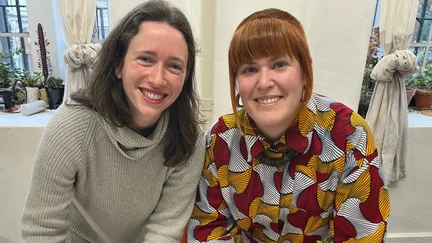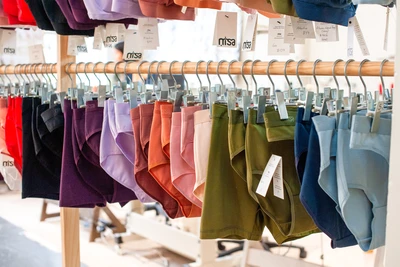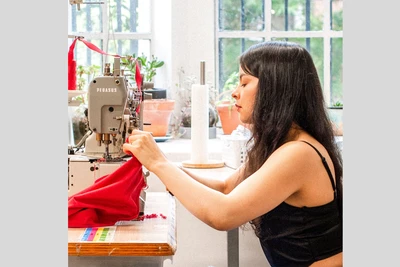Briefs with Beliefs : An Interview with Nisa's Pam Lowe
Our Business Specialist librarian interviews small Wellington businesses. Today we are happy to have Nisa.

When no buyer came forward after ethical and sustainable clothing label Nisa was put on the market at the end of 2023, the closure of this much-loved brand was announced.
Founded in 2017 by Elisha Watson, Nisa (meaning ‘women’ in Arabic) was originally established as a social enterprise providing training and meaningful employment for women from refugee and migrant backgrounds.
Not wanting to see this opportunity lost, a group of staff banded together at the last minute and launched a crowdfunding campaign to buy the business. Within 24 hours they had raised the money to not only purchase the operation, but to keep operating for the months following.
Former employee Pamela Lowe, a sample machinist and pattern maker by profession, has taken on the role of manager. WCL sat down with Pam to see what changes have taken place in the last twelve months.
WCL: It’s been a year since staff raised the funds to purchase Nisa. How’s it going?
Pam: It’s tough. There’s a feeling Wellington isn’t as vibrant as it once was, particularly from people from out of town.
In the twelve months since we did the Pledgeme campaign and ended up with Nisa, it’s been a really awesome ride. It’s been hairy and stressful at points, but it’s been amazing.
Right up until I had hit submit on the campaign, I had thought “Is this going to work?”. We got such an overwhelming response; it was really encouraging that people wanted us to stick around. People loved the products, they loved what we were doing and had a lot of belief in it.
So, not only was it a cash injection that the business needed to get back up and running, but also it was a huge boost for us - it let us know customers wanted to be able to buy our products.
WCL: How did you come up with a co-ownership business model that would work for the group?
Pam: Because it was so last minute there wasn’t a huge amount of thought put into that. It has evolved. We’ve had one person leave [since the group took over] so it is still evolving.
We had a meeting the other day to see how we could give shares to new employees that come on. Even the roles and who does what, because we are a small team, evolve and change with who’s needed where. The model we are using is one that is entirely made up on the fly.
WCL: What new skills did you need to learn in order to make the move from being employees to the responsibility of owning the company.
Pam: It’s been a really steep learning curve for me. I’ve gone from being the production manager here for six years before we took the business on. I have been on a heck of a lot of courses and I have got a lot of help from other founders and other start ups. We have a Business Mentor at Business HQ who has been invaluable. So a lot of upskilling. I’ve learnt a lot about finances. That’s the huge one at the moment. It’s learning all the financials and about that side of the business.
We were told by our lawyers initially that people don’t acquire a business in under six months and we had three weeks to make it happen. So there’s been a lot of learning, and being a bit naive has worked in our favour. Particularly pushing the sale of the business through quickly.
WCL: What changes have you made since you’ve come on board?
Pam: We’ve really had to diversify. We’ve slimmed down the offerings we have. That’s been in response to the economy and sales slowing down. The slowing down of sales has not only been because of the economic downturn but also we really flooded our customer base with products in the closedown sale.
In the closedown sale we sold about a years worth of stock, and then we also had the Pledgeme campaign which as like essentially a pre-sale so our customer base really have been well saturated [with product].
Now we really need to go further afield to find customers and to keep work coming in. Our employment mission is still the same. We’re here to provide employment to women from refugee and migrant backgrounds. We’ve started doing contract manufacturing for other labels. Other labels around New Zealand were finding the same pressures on their sales. They weren’t able to reach the volumes that they need to have things manufactured overseas. We’ve been manufacturing swimwear, active wear and underwear for other labels so that’s worked out quite well.
We’ve also slimmed down the team, which we see as a temporary measure, to get us through. It worked quite organically. In the period we were closed when we were acquiring the business, some of our staff found other jobs in other areas they wanted to stay in, so we didn’t re-employ. So that worked out happily for everyone for now.
We’ve changed a few other things like our packaging. We read a review that New Zealand Post had done. We had been using cardboard mailers but actually it’s more sustainable to use recycled plastic. We’ve swapped things like that.
We’re trying to go zero waste in our pattern making and manufacturing. Zero waste pattern making is a really creative approach to making things. If you’ve ever cut out a pattern you know there’s waste in between. It’s really time consuming to work it out.
Initially I’d looked at the merino range and I didn’t have time to completely make that zero waste, so we made that low waste. That was just about cutting and panelling all our patterns, wherever we can for the best use of the fabric. It means tesselating and butting up patterns against each other as much as we can and creating shapes that fit together better.
Then for the activewear range we decided we were going to do it zero waste. We did the leggings and the shorts zero waste and it really is just creatively cutting, but we have the benefit of using a high dense stretch fabric that has really good recovery. Because we are using a good recovery stretch fabric we have what we call rotation. We can go 20 degrees either way in our patterns.
We don’t cut for production here as we don’t have the space. We only cut for our samples here. Our cutting is done in Auckland by a computerised cutter. They have an automated system that will make all the markers laying out all the patterns. It is able to skew all those patterns 20 degrees to slot them in. But they were also made with the idea that the patterns needed to tesselate themselves so they are a lot of patterns that are long and thin, and there are a lot of straight edges rather than curves so we can then put everything together and create zero waste.
It’s a really labour-intensive process setting them up, but then once they are all good to go it’s saving us ten to fifteen percent on our fabric which is lowering what needs to go to landfill and its lowering what fabric we need to bring in. In turn, this lowers our carbon footprint.

Photo courtesy of Nisa
WCL: Where do you import your fabric from?
Pam: We have it made for us in a few different places. Our activewear fabric is made in China and that’s made from pre-consumer waste.
People don’t often talk about pre-consumer waste. That’s essentially the offcuts from other factories, carpets and textiles that would otherwise be going to landfill but is then recycled into our fabric.
Our organic cotton we get from Melbourne. It’s a really beautiful quality. Unfortunately there aren’t any working commercial mills left that would allow us to have our fabric made in New Zealand, so Melbourne is the closest we can get it. Our merino comes out of there as well.
We try wherever we can to get to source fabric as close as we can to us. We had looked at getting things from Melbourne for our active wear, but we couldn’t find something that ticked enough of our boxes.
WCL: There was a lot published in print and online about the sale and potential closure of Nisa, so what difficulties have you faced re-establishing your presence again after that?
Pam: We are still facing quite a lot of trouble from that, because people don’t know that we reopened. We’re really trying to build up the business so that we can get our marketing out to everyone.
We have a lot of our customer base who, in the closedown, unsubscribed from our mailing list. We still have people coming in who don’t know we have reopened.
But also building up stock again has been really hard because we haven’t had the sale numbers that we had prior to that. We are now running as a made to order business more. We hold very little amounts of stock. It does also mean we are not holding excess. If it’s not selling, we don’t make it.
WCL: If someone walks in off the street, and you don’t have something that's quite what they need, do you offer a fitting service?
Pam: We offer what we call customisations. These can take up to three weeks to make. Our most popular bras are soft cup, wire-free bralettes. We offer a customisation we can make you one with a bigger cup size and a smaller back or a smaller cup size and a bigger back. We can, to a point, get you something that is fitting really well.
We have also just launched our first ever underwire bra. The Pledgeme campaign allowed us to buy a casing machine so we could make underwire bras.
[Being mindful of comfort] I decided I would make the underwire bra a bit differently and I put all the seams and all the hardware on the outside so it’s the soft fabric against your skin to help ease any irritation. On the technical side, the underwire is also two sizes bigger so it really gives you shape, and is holding you, but there is enough room.
Our underwire bras have cup sizes but because we use a stretch fabric our cup sizes are a C-D and a DD-E. Again, we can customise.
For customisations it is best to come in-store, so we can make sure people are getting the right cup size. We can shorten straps, lengthen straps, so people are getting what they need.
WCL: Are you developing other new product lines?
Pam: At this stage we are really holding fire on new things. Just trying to really focus on what we have. I would love to do a swimwear line again this year, but we are not sure if we will be able to. We may run a pre-order, and if we get enough orders we would then make it. But if we don’t, we might not.

Photo courtesy of Nisa
WCL: Do you find the location on Willis St good for business?
Pam: We do get some walk-ins but we find it’s really good for people who want to pick up orders. There’s a lot of people around town who come in to collect their orders. We do still hold some stock so people can come in and buy something. We get people who come in to get last minute gifts and they might buy a gift card or a pair of socks.
It’s a really great location and being on the first floor our rent is not nearly anywhere near what those at Street level pay. We have the most lovely landlord too.
WCL: Do you get more sales via online or in-person? And how about national vs international markets.
Pam: We’re now looking at around 80 percent of sales online. It used to be that about 30-35 percent of our sales were walk-ins. In the last year that has definitely dropped [due to lack of people in the CBD].
It does seem some days, particularly around when there were all those government layoffs a few months back, it was almost like a Covid time again. I would look out the window and not see people which is so unusual for Willis St.
We’re getting quite a lot of sales from Australia and from the States as well. People looking for a more ethical option. And the exchange rate is in their favour.
WCL: Nisa has been running a customer survey – what has the response rate been like?
Pam: We have had good customer engagement. We do really value what people want.
We went to the customer base and said “We are struggling, can you help us, what would you like us to do?” The overwhelming response was they were really keen on the employment sponsorship. People have really got behind that which is awesome. It’s something we see as a short-term stopgap to help us get through this next year.
Basically, we would really love it if people can spare some money – we’ve given them options to get on board with supporting our workers. It would really help us get through.
We got some awesome feedback and some great creative ideas that we are going to put into use.
WCL: Why is it important to keep a business like Nisa operating in Wellington?
Pam: I’m a huge champion for manufacturing in New Zealand. I’m super passionate about keeping our skills, our knowledge here. Because if we don’t, we are so close to losing it.
I see the staff who come in here and I see the good that it does in their lives.
So not only do we keep manufacturing going and keep [the skills] in New Zealand we give our staff an opportunity.
Moving to another country is not the easiest time for them so it’s nice to come to an environment where not only are you doing something meaningful and something that you enjoy, but where you also have a safe environment where you can just be yourselves and have a nice time. To have a bit of a community around you when you might otherwise not.
Wellington is such a creative place as well, Whitecliffe, the fashion school, are just down on Lambton Quay. They’ve just brought in a Sustainable fashion design degree. So having places like Nisa around [shows the practicalities of that learning].
We’ve also started to run workshops where people can come in and learn how to make their own briefs, bra and make your own swimsuit. People come in for one night a week for up to six weeks. There’s something about using your brain and your hands that is a very soothing thing to do.
WCL: How many people do you take on each course and what level of sewing competence is required?
Pam: The briefs take up to eight people, and the bra and swimsuit workshops take up to six.
We’ve also run a t-shirt workshop and for that and the briefs workshop you need no skills.
I’m not saying they will come out perfect, but you will have wearable briefs or a wearable t-shirt at the end. For the bra and swimsuit workshop you need to either be a confident home sewer or have done the t-shirt or briefs workshop.
They’re fun days out. We’ve had groups come in to do them as team building exercises.
WCL: Your models have a body positivity and a diversity not normally seen in underwear advertisements. Where do you find your models?
Pam: We often ask people we know if they would like to model, but we also have people approach us who would like to do it. We really believe that if you want to buy something you want to see yourself in it. Nisa has never had runway models. We’ve always just used regular everyday people because this is regular, everyday underwear for everyone. All body shapes, all body types.
WCL: The next twelve months - what do you hope for?
Pam: I really hope we make it through. It could still go either way. Everyone is in the same boat, how long can we hold on for?
It’s doom and gloom but we are doing really cool, positive things.
Once we get through this it would be nice to offer swimwear all year round, merino all year round, but at this stage it’s just heads down.
We’ve got some new colours coming out and some exciting collaborations, with some really cool brands coming up so yeah, watch this space. There is still stuff happening in the background. How much we can do just depends on how our sales go.
I hope the economy picks up and we can employ more staff. That’s my hope.
Interested in some of the ideas raised in this interview. Have a look at some further reading from the WCL collection.
- The hidden power of your customers : four keys to growing your business through existing customers by Becky Carroll
- Winning new business by Stewart Stuchbury
- Crowdfunding intelligence : the no-nonsense guide to raising investment funds on the Internet by Chris Buckingham
- A crowdfunder's strategy guide : build a better business by building community by Jamey Stegmaier